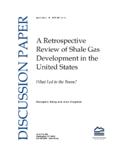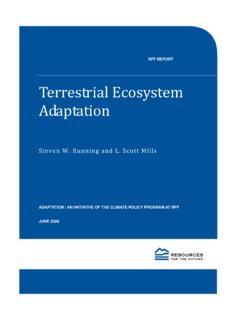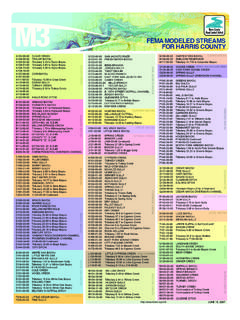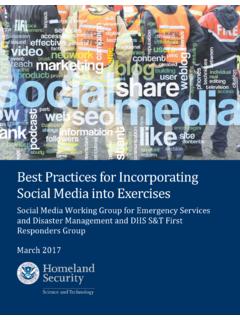Transcription of NFIP Premiums for Single-Family Residential …
1 | 1 DEC. 2016 | NO. 16-10 NFIP Premiums for Single-Family Residential properties : today and Tomorrow Carolyn Kousky, Brett Lingle, and Leonard Shabman Key Points Premiums for a newer primary residence in a 100-year floodplain with $250,000 of building coverage can range, under plausible assumptions, from $380 $590 when the home is 2 4 feet above base flood elevation (BFE) or from $650 $1,890 at BFE. Outside 100-year floodplains, Premiums are not based on elevation. Premiums can range from hundreds to a couple thousand dollars, depending on coverage choices and structural aspects of the home. For properties outside the 100-year floodplain with a favorable loss history, low Premiums are available; the cost for the maximum building and contents coverage for these policies is only $450 $500.
2 In 2014, only 1 percent of policies were in V zones (100-year floodplains subject to breaking waves of 3 feet or more). For newer homes in this zone, annual Premiums are several thousands of dollars, increasing dramatically if the property is below BFE. Pre-FIRM rates (for homes built before flood risks were mapped) currently provide savings of thousands of dollars annually to homes below BFE, but are actually more costly to homes above BFE. These discounts are being phased out for all policyholders. The highest Premiums are for properties below BFE. If a property is below BFE due to a new map, grandfathering can provide rate protection. For properties above BFE, however, grandfathering may not be preferable. Kousky, fellow, Resources for the Future (RFF); Lingle, research assistant, RFF; Shabman, resident scholar, RFF.
3 For more information, contact Kousky at The authors would like to thank Austin Perez and John Miller for helpful feedback on the content of this report. Kousky, Lingle, and Shabman | RFF Policy Brief 16-10 | 2 Introduction The federal government has been providing flood insurance to residents of participating communities since 1968 through the National Flood Insurance Program (NFIP). Communities can voluntarily join the program, adopting minimum floodplain regulations, and in exchange their residents become eligible to purchase flood insurance. Currently, a flood insurance policy is mandatory for properties located in a 100-year floodplain with a mortgage from a federally backed or regulated lender. The program has grown over the decades to become quite substantial.
4 As of June 2016, there were over million policies in force nationwide, representing slightly less than $ trillion in coverage. In 2012 and 2014, Congress passed legislation modifying NFIP pricing practices in an attempt to make the program more fiscally sound. Notably, these laws called for the phasing out of pre-FIRM rates, which are discounts given to homes built before flood hazards were mapped in a community (see below). This policy brief provides a short overview of NFIP rate setting and then presents annual Premiums for illustrative examples of Single-Family properties . Currently, almost 68 percent of all policies in force nationwide are for Single-Family homes. This brief also shows, for illustrative homes, the savings (or costs) from pre-FIRM rates, how such rates will be increasing, and examples of the premium savings possible from grandfathering.
5 Our premium calculations should not be taken as estimates for any particular property. Potential policyholders should contact an agent for accurate premium estimates. An Overview of NFIP Rate Setting The Federal Emergency Management Agency (FEMA) maps flood hazards on Flood Insurance Rate Maps (FIRMs). FIRMs delineate different flood risk zones. Areas modeled as the 1 percent annual chance floodplain, or 100-year floodplain, are referred to as Special Flood Hazard Areas (SFHAs). These are divided into two broad groups: A zones and V zones (areas subject to breaking waves of 3 feet or more). FEMA also maps the 500-year floodplain (referred to as shaded X on FIRMs) and areas outside both SFHAs and 500-year floodplains (referred to as unshaded X).
6 Single-Family residences (and two- to four-dwelling residences) in participating communities can purchase up to $250,000 of building coverage and $100,000 of contents coverage. Minimum deductibles for properties rated full risk by the NFIP are generally $1,000 or $1,250, with higher ones available. Private companies write policies on behalf of the program and process claims, but all the risk is borne by the NFIP. The NFIP, not companies, set rates. Roughly 80 percent of policies are currently paying NFIP full-risk rates. FEMA defines a full-risk premium rate as one charged to a group of policies that results in aggregate Premiums sufficient to pay anticipated losses and expenses for that group. 1 These rates are not subject to any price discounts, with the exception of discounts from community participation in the 1 See: Kousky, Lingle, and Shabman | RFF Policy Brief 16-10 | 3 Community Rating System (a voluntary program that rewards additional community actions that reduce flood risk).
7 Inside the SFHA, rates vary by zone and certain characteristics of the house, as seen in the tables below. Rates are higher for homes below base flood elevation (BFE), or the estimated height of waters during a 100-year flood. NFIP Premiums may not be equivalent to private sector prices, for a variety of reasons. There is no cost of capital in NFIP rates and the program does not explicitly price for the risk of the aggregate portfolio. The NFIP classifies the first $60,000 of building coverage for Single-Family homes as the basic limit and charges higher rates for coverage under this amount, since losses are more likely to occur in this range. The basic limit threshold, however, is a fixed dollar value and is not a percentage of the home value.
8 As such, this makes insurance more expensive for lower valued homes and could be a cross-subsidy from lower valued to higher valued structures. For properties outside the SFHA, the NFIP has two primary rates: Zone X and Preferred Risk Policy (PRP) rates. Zone X comprises areas both within and outside the 500-year floodplain; rates are the same in both. Outside the SFHA, FEMA does not rate based on elevation relative to the BFE and rates are thus not fully risk-based. Zone X is also subject to adverse selection in that only the riskiest properties in this zone voluntarily purchase insurance; FEMA accounts for this in the rate. For properties with a favorable loss history and outside SFHAs, FEMA offers PRP rates. These are lower rates for properties that are currently in an X zone and have not had any of the following: two claims of more than $1,000 each, three or more claims of any amount, two federal disaster aid payments of more than $1,000 each, three federal disaster aid payments for separate occurrences for any amount, or one insurance claim and two federal aid payments of more than $1,000 each.
9 There are two main groups that pay less than NFIP risk-based rates. The first are pre-FIRM properties . At the time the NFIP was created, over a million structures in the nation s floodplains had been constructed, often without being subject to any building code. Full-risk insurance rates for these existing structures would have been high, given the risk. Congress, therefore, created a discounted rate structure for pre-existing development, referred to as pre-FIRM policies. As of July 2012, there were million NFIP policies, with just over 19 percent of these policies receiving pre-FIRM discounted rates (A. Neal, pers. comm.; July 19, 2012). Pre-FIRM rates are not set according to the height of the first floor relative to the BFE, as is done for full-risk properties in SFHAs.
10 FEMA does not receive taxpayer funds to offset these lower rates. Pre-FIRM properties sustain more damage and have higher claims than post-FIRM properties (GAO 2010; Kousky and Michel-Kerjan 2015). As a result of legislation in 2012 and 2014, pre-FIRM rates are being phased out over time. Pre-FIRM Premiums for Single-Family properties must increase by at least 5 percent per year, but no more than 18 percent per year (not including fees). Elevation certificates are required to rate post-FIRM properties . As pre-FIRM rates are eliminated, property owners are encouraged to submit an elevation certificate to the NFIP. Until they do so, rates will continue to increase on their property. Non-primary residences, businesses, severe repetitive loss properties , and properties substantially damaged or improved with pre-FIRM rates will see their Premiums increase 25 percent per year until they reach the full-risk rate.














